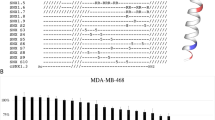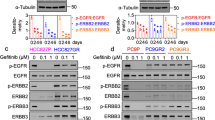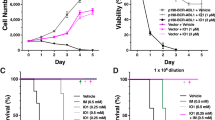Abstract
We have examined the possible mechanisms of resistance to the epidermal growth factor receptor (EGFR) inhibitors in tumor cells with variable levels of EGFR. ZD1839 (Iressa) is a small-molecular-weight, ATP-mimetic that specifically inhibits the EGFR tyrosine kinase. A431 cell growth was markedly inhibited by ZD1839 (IC50⩽0.1 μ M) whereas the MDA-468 cells were relatively resistant (IC502 μ M). Low doses of ZD1839 delayed cell cycle progression and induced apoptosis in A431 cells but not in MDA-468 cells. In both cell lines, 0.1 μ M ZD1839 eliminated EGFR phosphorylation. However, the basal activity of the phosphatidylinositol-3 kinase (PI3 K) target Akt was eliminated in A431 but not in MDA-468 cells, implying that their Akt activity is independent of EGFR signals. A431 cells express PTEN/MMAC1/TEP, a phosphatase that can dephosphorylate position D3 of phosphatidylinositol-3,4,5 trisphosphate, the site that recruits the plecstrin-homology domain of Akt to the cell membrane. On the contrary, MDA-468 cells lack the phosphatase and tensin homolog (PTEN), potentially setting Akt activity at a high threshold that is unresponsive to EGFR inhibition alone. Therefore, we reintroduced (PTEN) by retroviral infection in MDA-468 cells. In MDA-468/PTEN but not in vector controls, treatment with ZD1839 inhibited P-Akt levels, induced relocalization of the Forkhead factor FKHRL1 to the cell nucleus, and increased FKHRL1-dependent transcriptional activity. ZD1839 induced a greater degree of apoptosis and cell cycle delay in PTEN-reconstituted than in control cells. These data suggest that loss of PTEN, by permitting a high level of Akt activity independent of receptor tyrosine kinase inputs, can temporally dissociate the inhibition of the EGFR with that of Akt induced by EGFR inhibitors. Thus, in EGFR-expressing tumor cells with concomitant amplification(s) of PI3K-Akt signaling, combined blockade of the EGFR tyrosine kinase and Akt should be considered as a therapeutic approach.
This is a preview of subscription content, access via your institution
Access options
Subscribe to this journal
Receive 50 print issues and online access
$259.00 per year
only $5.18 per issue
Buy this article
- Purchase on Springer Link
- Instant access to full article PDF
Prices may be subject to local taxes which are calculated during checkout







Similar content being viewed by others
References
Albanell J, Codony-Servat J, Rojo F, Del Campo JM, Sauleda S, Anido J, Raspall G, Giralt J, Rosello J, Nicholson RI, Mendelsohn J and Baselga J . (2001). Cancer Res., 61, 6500–6510.
Ali IU, Schriml LM and Dean M . (1999). J. Natl. Cancer Inst., 91, 1922–1932.
Arteaga CL . (2001). J. Clin. Oncol., 19, 32S–40S.
Baselga J, Rischin D, Ranson M, Calvert H, Raymond E, Kieback DG, Kaye SB, Gianni L, Harris A, Bjork T, Averbuch SD, Feyereislova A, Swaisland H, Rojo F, & Albanell J . (2002). J. Clin. Oncol., 20 4292–4302.
Bellacosa A, de Feo D, Godwin AK, Bell DW, Cheng JQ, Altomare DA, Wan M, Dubeau L, Scambia G, Masciullo V et al. (1995). Int. J. Cancer, 64, 280–285.
Brognard J, Clark AS, Ni Y and Dennis PA . (2001). Cancer Res., 61, 3986–3997.
Brunet A, Bonni A, Zigmond MJ, Lin MZ, Juo P, Hu LS, Anderson MJ, Arden KC, Blenis J and Greenberg ME . (1999). Cell, 96, 857–868.
Busse D, Doughty RS, Ramsey TT, Russell WE, Price JO, Flanagan WM, Shawver LK and Arteaga CL . (2000). J. Biol. Chem., 275, 6987–6995.
Cantley LC and Neel BG . (1999). Proc. Natl. Acad. Sci. USA, 96, 4240–4245.
Carpenter G . (1999). J. Cell Biol., 146, 697–702.
Chakravarti A, Loeffler JS and Dyson NJ . (2002). Cancer Res., 62, 200–207.
Chan TO, Rittenhouse SE and Tsichlis PN . (1999). Annu. Rev. Biochem., 68, 965–1014.
Datta SR, Brunet A and Greenberg ME . (1999). Genes Dev., 13, 2905–2927.
D'Cruz CM, Gunther EJ, Boxer RB, Hartman JL, Sintasath L, Moody SE, Cox JD, Ha SI, Belka GK, Golant A, Cardiff RD and Chodosh LA . (2001). Nat. Med., 7, 235–239.
Ennis BW, Valverius EM, Bates SE, Lippman ME, Bellot F, Kris R, Schlessinger J, Masui H, Goldenberg A and Mendelsohn J et al. (1989). Mol. Endocrinol., 3, 1830–1838.
Fan Z, Shang BY, Lu Y, Chou JL and Mendelsohn J . (1997). Clin. Cancer Res., 3, 1943–1948.
Fedi P, Pierce JH, di Fiore PP and Kraus MH . (1994). Mol. Cell Biol., 14, 492–500.
Forgacs E, Biesterveld EJ, Sekido Y, Fong K, Muneer S, Wistuba II, Milchgrub S, Brezinschek R, Virmani A, Gazdar AF and Minna JD . (1998). Oncogene, 17, 1557–1565.
Fry MJ . (2001). Breast Cancer Res., 3, 304–312.
Goldstein NI, Prewett M, Zuklys K, Rockwell P and Mendelsohn J . (1995). Clin. Cancer Res., 1, 1311–1318.
Grignani F, Kinsella T, Mencarelli A, Valtieri M, Riganelli D, Lanfrancone L, Peschle C, Nolan GP and Pelicci PG . (1998). Cancer Res., 58, 14–19.
Gschwind A, Zwick E, Prenzel N, Leserer M and Ullrich A . (2001). Oncogene, 20, 1594–1600.
Hermanto U, Zong CS and Wang LH . (2001). Oncogene, 20, 7551–7562.
Kohno T, Takahashi M, Manda R and Yokota J . (1998). Genes Chromosomes Cancer, 22, 152–156.
Kops GJ and Burgering BM . (1999). J. Mol. Med., 77, 656–665.
Lane HA, Beuvink I, Motoyama AB, Daly JM, Neve RM and Hynes NE . (2000). Mol. Cell Biol., 20, 3210–3223.
Lenferink AE, Busse D, Flanagan WM, Yakes FM and Arteaga CL . (2001). Cancer Res., 61, 6583–6591.
Lenferink AE, Simpson JF, Shawver LK, Coffey RJ, Forbes JT and Arteaga CL . (2000). Proc. Natl. Acad. Sci. USA, 97, 9609–9614.
Li DM and Sun H . (1998). Proc. Natl. Acad. Sci. USA, 95, 15406–15411.
Lu Y, Lin YZ, LaPushin R, Cuevas B, Fang X, Yu SX, Davies MA, Khan H, Furui T, Mao M, Zinner R, Hung MC, Steck P, Siminovitch K and Mills GB . (1999). Oncogene, 18, 7034–7045.
Lu Y, Zi X, Zhao Y, Mascarenhas D and Pollak M . (2001). J. Natl. Cancer Inst., 93, 1852–1857.
Moasser MM, Basso A, Averbuch SD and Rosen N . (2001). Cancer Res., 61, 7184–7188.
Moulder SL, Yakes FM, Muthuswamy SK, Bianco R, Simpson JF and Arteaga CL . (2001). Cancer Res., 61, 8887–8895.
Moyer JD, Barbacci EG, Iwata KK, Arnold L, Boman B, Cunningham A, DiOrio C, Doty J, Morin MJ, Moyer MP, Neveu M, Pollack VA, Pustilnik LR, Reynolds MM, Sloan D, Theleman A and Miller P . (1997). Cancer Res., 57, 4838–4848.
Nakatani K, Thompson DA, Barthel A, Sakaue H, Liu W, Weigel RJ and Roth RA . (1999). J. Biol. Chem., 274, 21528–21532.
Nelson JM and Fry DW . (2001). J. Biol. Chem., 276, 14842–14847.
Olayioye MA, Neve RM, Lane HA and Hynes NE . (2000). EMBO J., 19, 3159–3167.
Perren A, Weng LP, Boag AH, Ziebold U, Thakore K, Dahia PL, Komminoth P, Lees JA, Mulligan LM, Mutter GL and Eng C . (1999). Am. J. Pathol., 155, 1253–1260.
Prenzel N, Fischer OM, Streit S, Hart S and Ullrich A . (2001). Endocr. Relat. Cancer, 8, 11–31.
Ranson M, Hammond LA, Ferry D, Kris M, Tullo A, Murray PI, Miller V, Averbuch S, Ochs J, Morris C, Feyereislova A, Swaisland H and Rowinsky EK . (2002). J. Clin. Oncol., 20, 2240–2250.
Rodrigues GA, Falasca M, Zhang Z, Ong SH and Schlessinger J . (2000). Mol. Cell Biol., 20, 1448–1459.
Shayesteh L, Lu Y, Kuo WL, Baldocchi R, Godfrey T, Collins C, Pinkel D, Powell B, Mills GB and Gray JW . (1999). Nat. Genet., 21, 99–102.
Shin I, Bakin AV, Rodeck U, Brunet A and Arteaga CL . (2001). Mol. Biol. Cell, 12, 3328–3339.
Shin I, Yakes PM, Rojo R, Shin NY, Bakin AV, Baselga J and Arteaga CL . (2002). Nat. Med., 8, 1145–1152.
Simpson L and Parsons R . (2001). Exp. Cell Res., 264, 29–41.
Sun H, Lesche R, Li DM, Liliental J, Zhang H, Gao J, Gavrilova N, Mueller B, Liu X and Wu H . (1999). Proc. Natl. Acad. Sci. USA, 96, 6199–6204.
Sun M, Paciga JE, Feldman RI, Yuan Z, Coppola D, Lu YY, Shelley SA, Nicosia SV and Cheng JQ . (2001a). Cancer Res., 61, 5985–5991.
Sun M, Wang G, Paciga JE, Feldman RI, Yuan ZQ, Ma XL, Shelley SA, Jove R, Tsichlis PN, Nicosia SV and Cheng JQ . (2001b). Am. J. Pathol., 159, 431–437.
Teng DH, Hu R, Lin H, Davis T, Iliev D, Frye C, Swedlund B, Hansen KL, Vinson VL, Gumpper KL, Ellis L, El-Naggar A, Frazier M, Jasser S, Langford LA, Lee J, Mills GB, Pershouse MA, Pollack RE, Tornos C, Troncoso P, Yung WK, Fujii G, Berson A and Steck PA et al. (1997). Cancer Res., 57, 5221–5225.
Van de Vijver MJ, Kumar R and Mendelsohn J . (1991). J. Biol. Chem., 266, 7503–7508.
Vivanco I and Sawyers CL . (2002). Nat. Rev. Cancer, 2, 489–501.
Vlahos CJ, Matter WF, Hui KY and Brown RF . (1994). J. Biol. Chem., 269, 5241–5248.
Vogel CL, Cobleigh MA, Tripathy D, Gutheil JC, Harris LN, Fehrenbacher L, Slamon DJ, Murphy M, Novotny WF, Burchmore M, Shak S, Stewart SJ and Press M . (2002). J. Clin. Oncol., 20, 719–726.
Wakeling AE, Guy SP, Woodburn JR, Ashton SE, Curry BJ, Barker AJ and Gibson KH . (2002). Cancer Res., 62, 5749–5754.
Yakes FM, Chinratanalab W, Ritter CA, King W, Seelig S and Arteaga CL . (2002). Cancer Res., 62, 4132–4141.
Yarden Y and Sliwkowski MX . (2001). Nat. Rev. Mol. Cell Biol., 2, 127–137.
Yu H and Rohan T . (2000). J. Natl. Cancer. Inst., 92, 1472–1489.
Zhou BP, Liao Y, Xia W, Spohn B, Lee MH and Hung MC . (2001a). Nat. Cell Biol., 3, 245–252.
Zhou BP, Liao Y, Xia W, Zou Y, Spohn B and Hung MC . (2001b). Nat. Cell Biol., 3, 973–982.
Acknowledgements
This work was supported in part by NIH Grant R01 CA80195 (to CLA) and Vanderbilt-Ingram Comprehensive Cancer Center support Grant CA68485.
Author information
Authors and Affiliations
Corresponding author
Rights and permissions
About this article
Cite this article
Bianco, R., Shin, I., Ritter, C. et al. Loss of PTEN/MMAC1/TEP in EGF receptor-expressing tumor cells counteracts the antitumor action of EGFR tyrosine kinase inhibitors. Oncogene 22, 2812–2822 (2003). https://doi.org/10.1038/sj.onc.1206388
Received:
Revised:
Accepted:
Published:
Issue Date:
DOI: https://doi.org/10.1038/sj.onc.1206388
Keywords
This article is cited by
-
Targeting PI3K/Akt signal transduction for cancer therapy
Signal Transduction and Targeted Therapy (2021)
-
mTOR-Rictor-EGFR axis in oncogenesis and diagnosis of glioblastoma multiforme
Molecular Biology Reports (2021)
-
Genetically distinct glioma stem-like cell xenografts established from paired glioblastoma samples harvested before and after molecularly targeted therapy
Scientific Reports (2019)
-
NOTCH3 inactivation increases triple negative breast cancer sensitivity to gefitinib by promoting EGFR tyrosine dephosphorylation and its intracellular arrest
Oncogenesis (2018)
-
Epidermal growth factor receptor and EGFRvIII in glioblastoma: signaling pathways and targeted therapies
Oncogene (2018)



